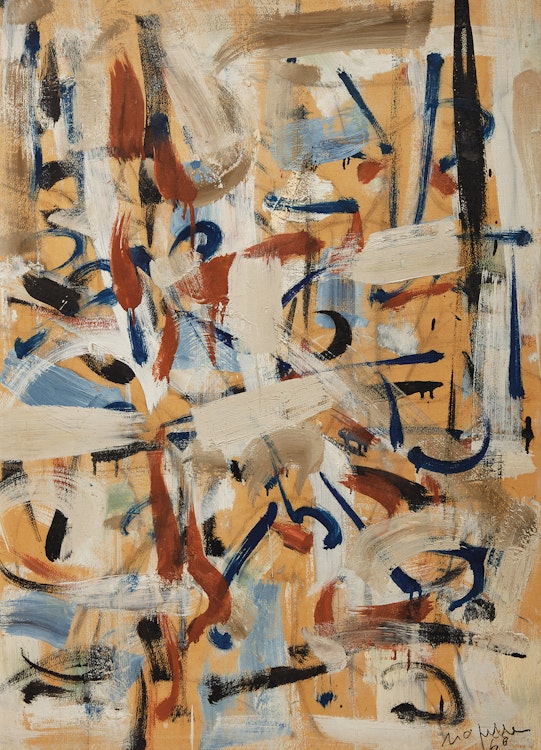Composition by Jean Paul Riopelle

Jean Paul Riopelle
Composition
oil on paper on canvas
signed and dated 1958 lower right; catalogue raisonné no. 1958.060P
30.5 x 22 in ( 77.5 x 55.9 cm )
Auction Estimate: $30,000.00 - $50,000.00
Price Realized $55,200.00
Sale date: May 30th 2024
Private Collection, Toronto
"Composition" was painted in 1958, during the early years of Riopelle and Mitchell’s romance. Executed in oil on paper mounted on canvas, the work bears similarities to his experimental gouaches of the time. The delicate, overlapping layers of paint with exposed ground recall the the effects of gouache and create a stark contrast to the thick impasto of his mosaics.
Share this item with your friends
Jean Paul Riopelle
(1923 - 2002) Les Automatistes, RCA, SCA
Born in 1923, Jean Paul Riopelle is one of Canada’s most significant artists from the twentieth century. Born in Montréal, Quebec, Riopelle was educated at the Saint-Louis-de-Gonzague school. In 1936, he began taking painting and drawing classes on the weekends that Henri Bisson, a sculptor who often drew from life, taught in the Riopelle family home. Much of Riopelle’s early works can be traced to his time spent learning under Bisson and are attempts at direct representations from life. For example, Nature bien morte (1942) is a copy of Bisson’s work. Riopelle, advised by his parents, enrolled in the École Polytechnique de Montréal in 1941 to study architecture and engineering. However, he did poorly in his courses and enrolled in the École des beaux-arts and then the École du meuble.
At the École du meuble, Riopelle was taught by Paul-Émile Borduas. Initially, Riopelle could not let go of the academic style taught to him by Bisson in favor of Borduas’ abstract style. Eventually, inspired by automatic writing and painting exercises Riopelle embraced his unconscious imagination and began working in an abstract style. Riopelle was also inspired by the paintings of Vincent van Gogh. In 1944, he produced his first abstracted work in Saint-Fabien. The painting, now lost, was a representation of a water hole left on the shore of the Saint Lawrence River. Riopelle, alongside other young Automatistes, spent part of the winter of 1944-45 with Borduas in Mont-Saint-Hilaire exploring radical ideas about art and politics, which would eventually manifest themselves in the Refus global manifesto.
In early 1946, Riopelle took part in the first Automatistes exhibition, Exposition de peinture, in Montréal. In the same year, Riopelle travelled to France for the first time while working as a horse groomer and became enamored by paintings of horses by Théodore Géricault and by Impressionist works at the Musée de l’Orangerie. Riopelle returned to France in December 1946 and met André Breton who invited Riopelle to participate in a Surrealist exhibition in the following year. Because Breton was somewhat dismissive of the Automatistes, Riopelle was the only Automatistes to participate in the Exposition international du surréalisme in 1947. Inspired by the French Surrealists, upon Riopelle’s return to Canada he encouraged the Automatistes to produce their own manifesto. The manifesto, Refus global, was an anarchistic proclamation published in 1948.
Georges Mathieu invited Riopelle to participate in an international exhibition titled Véhémences confrontées alongside Jackson Pollock and Willem de Kooning. Feeling detached from Breton’s Surrealism Riopelle began producing a body of work that would eventually be known as mosaics. Favoring a pallet knife over a brush, Riopelle was renown through the 1950s for his larger than life canvases. In the summer of 1960, Riopelle began sculpting. Riopelle represented Canada at the Venice Biennale in 1962; exhibiting both paintings and bronze cast sculptures earning him the UNESCO Prize. After appearing in the Venice Biennale, throughout the late 1960s, Riopelle began working in a fragmented style that is reminiscent of collages. In 1969, Riopelle began working on La Joute, which would eventually be installed in the Olympic Park at the 1976 Summer Olympic Games in Montréal. The installation features a fountain surrounded by abstract animal and human figures.
Beginning in the 1980s, numerous Canadian institutions began retrospective exhibitions of Riopelle’s work, including the National Gallery of Canada, the Musée d’art contemporain de Montréal, and the Art Gallery of Peterborough. The Musée national d’art modern de Paris organized a retrospective of his work that would travel to Montréal, Mexico City, and Caracas, Venezuela. In 1981, Riopelle was presented the Prix Paul-Émile-Borduas due to his contributions to cultural life.
Literature Source:
Gagnon, François-Marc. Jean Paul Riopelle: Life and Work. Art Canada Institute, 2019
We extend our thanks to Danie Klein, York University graduate student in art history, for writing and contributing this artist biography.

